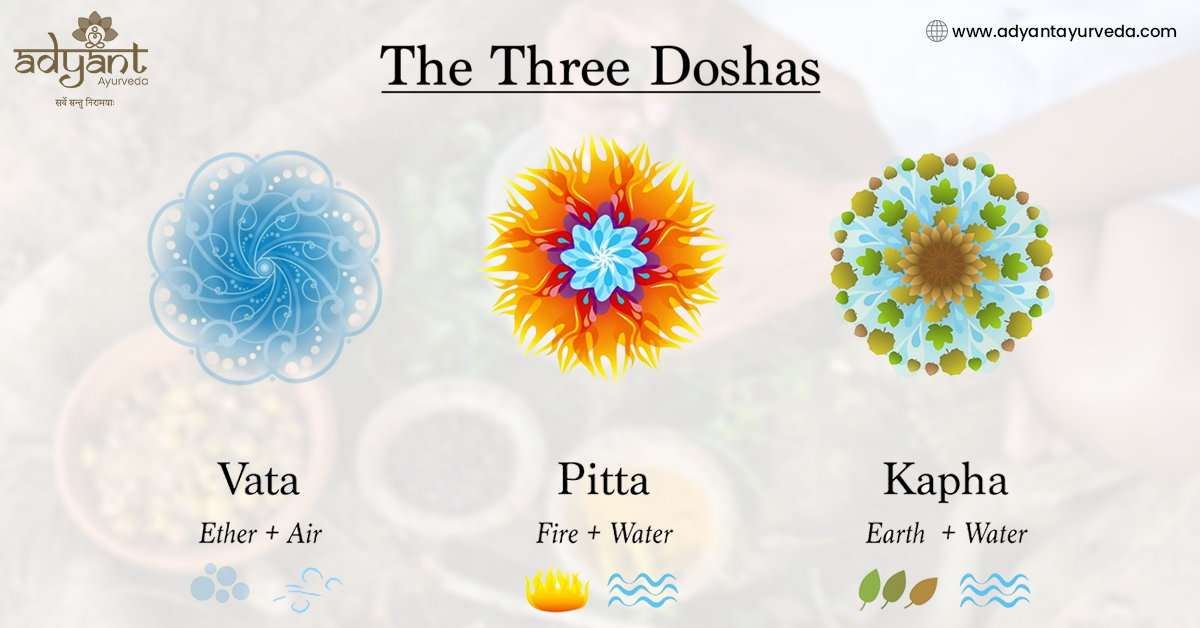In Ayurveda Treatment, the Tridosha (Vata, Pitta, and Kapha) are energetic forces of nature, functional fundamentals that help us understand ourselves and the world. Because Vata, Pitta, and Kapha are all necessary for our physiology, no dosha is better than or superior to the others. Each performs a distinct set of functional roles in the body. However, when the doshas are out of balance, they can have a negative impact on our health.
The entire Ayurveda’s healing system is based on these three Doshas. This article describes these natural forces and how they can affect our health and well-being. To know more, consult the Best Ayurveda Clinic.
The Elements of Ayurveda and the Three Doshas
The three types of Doshas, or primary functional energies in the body, are Vata, Pitta, and Kapha. Vata is associated with the wind. Pitta is associated with fire, while Kapha is associated with water. These Doshas are associated with natural elements. Nature is thought to be comprised of five elements. These five elements are as follows:
- Prithvi (Earth)
- Air (Vayu)
- Water (Jala)
- Teja (Fire)
- Aakash (space)
The elements of nature have a strong relationship with Vata, Pitta, and Kapha. The following describes the relationship:
- Vata Dosha is associated with air and space.
The Ayurveda element associated with air and space is vata dosha. This dosha is light, cold, and dry in nature. It governs the movement and processes of our body and mind, displaying processes such as blood flow, waste elimination, breathing, the nervous system, joint movements, and the occurrence of thoughts.
- Pitta Dosha is associated with both fire and water.
Pitta dosha is based on the elements of fire and water. This dosha is hot, light, sharp, fluid, oily, and mobile in nature. Pitta is frequently associated with summer and its hot and sunny days. It has an impact on the digestive system, the skin and complexion, the body temperature, and metabolism.
- Kapha Dosha is associated with the earth and water.
The Ayurveda element Kapha dosha is linked to earth and water. The characteristics of the Kapha dosha are slow, moist, cool, heavy, smooth, and oily. In addition, Kapha represents structure, stability, and lubrication in the body and mind.
Aspects of the Doshas’ Innate Nature
Understanding the differences between the Kapha, Vata, and Pitta doshas is essential.
- Being made of air and space, vata is light, clear, mobile, subtle, dry, cold, and rough.
- Pitta is a combination of fire and water, making it hot, light, sharp, lubricious, and liquid.
- Earth and water combine to form the kapha, which is stable, cloudy, heavy, slow, smooth, oily, and soft.
- Ayurveda types of bodies can be identified based on the qualitative characteristics of the Doshas. This is a person’s constitution, which is determined by the dominant Dosha. Based on the dominant Doshas, each Ayurveda body type has a unique body constitution. Vata, Pitta, and Kapha are the three primary body types according to Ayurveda.
Body Type: Vata
People with a Vata body type have a predominately Vata Dosha with more Vata-related qualities and traits. Vata body types in Ayurveda Treatment are typically lean and vigorous. They frequently have original ideas and are creative people. The weather and the food they eat can frequently affect how they feel. The Vata-type body has the following characteristics.
- Rapid learner
- Being imaginative
- Multitasker
- Kind Nature
- Flexible
- Slim
- Emotional instability
- Prone to feeling anxious
- Easily affected by cold weather
- The appetite can change, and digestive issues could surface.
- Impeded blood flow
- Sleep issues
Body type: Pitta
The pitta-type body combines elements of fire and water. These are typically well-built, athletic people. They can come off as aggressive and goal-oriented by nature, and they have strong leadership skills. The Pitta-type constitution has the following strong qualities:
- Intelligence
- Swift scholars
- Goal-oriented and driven
- Powerful leadership skills
- A healthy cardiovascular system
- Good metabolism
- Healthy skin and hair
- Tenacious and determined
- Lack of endurance
- May easily engage in conflicts
- Might experience mood swings and hunger pangs
- Especially sensitive to heat
- The most common health issue is inflammation.
Body type: Kapha
The water element is present in the earthy Kapha body type. They become more rooted and steady as a result. These are strong, compassionate people by nature. They not only complete tasks, but they also support and assist others.
The following traits are typical of those with a Kapha body constitution:
- Being compassionate and empathetic
- Trust others
- Maintain your composure and patience
- Mature and sage
- Happy
- Solid joints and bones
- Immunity is typically sturdy.
- They may be lethargic due to a slow metabolism.
- They might wind up gaining weight quickly.
- Tend to sleep too much
- Susceptible to respiratory problems
- Heart disease risk is higher
- Need inspiration or risk becoming depressed
In addition to the three Ayurveda body types mentioned above, there are also Vata-Pitta, Pitta-Vata, Pitta-Kapha, Kapha-Pitta, etc. body types. When more than one Dosha is predominant, the combination happens. Ayurveda also combines two different types to describe the characteristics of each body type. Visit the Top Ayurveda Hospital to get detailed information.
The Tridoshic body type, in which all three Doshas are perfectly balanced, is another Ayurveda body type. This body type is typically stable and in excellent health. The three Doshas’ opposing forces balance one another, promoting general health.
FUNCTIONS OF VATA, PITTA, & KAPHA:
Based on the elemental forces they are composed of, each of the three doshas performs a particular function. Movement, digestion, and structure are all governed by Vata, Pitta, and Kapha, respectively. Each of the doshas carries out particular bodily tasks.
Functions of Vata Dosha:
- All bodily movements are controlled by the Vata Dosha. Usually, it is found in the lower abdomen, just below the navel.
- Vata controls all of the body’s natural urges, including hunger, thirst, urination, excretion, sleep, etc. It also contributes to the smooth operation of processes like respiration and preserves the health of the Dhatus, or tissues.
- The heart, muscle contractions, blood flow, and communication from the brain through the nerves to the entire body are all made possible by Vata.
Functions of Pitta Dosha:
- The body’s metabolism and efficient digestion are under the control of the Pitta Dosha.
- It is thought to be in the upper abdominal region, above the navel.
- Pitta is related to fire, maintaining a healthy body temperature. It develops mental acuity and physical lustre. Since it is connected to transformation, it controls how we feel and what we experience.
Functions of the Kapha Dosha
- The body receives vigour, vitality, and immunity from Kapha. It’s thought to be in the chest area.
- It can guarantee the skeletal system’s sturdiness and stability. It hydrates the tissues and cells because it contains the element water. The skin is kept moisturised as a result. It provides lubrication for the joints, enabling smooth operation. Consult a Famous Ayurveda Doctor to know more.
Imbalance or Vitiation of the Doshas
A balanced Dosha system guarantees good health. However, it is frequently possible for the Doshas to become vitiated, which would result in an imbalance. There are many causes of dosha imbalance, including:
- Improper diet, where the food consumed is not in harmony with the dominant Dosha.
- Improper daily routines are caused by poor lifestyle management.
- Stress and tension that result in trauma or anxiety.
- Whatever the cause, the state of harmony can be disturbed when any of the Doshas become vitiated. This may negatively affect health. Any Dosha that is vitiated produces excess Dosha, which can result in certain symptoms or medical conditions. The disturbance that is brought about is distinct and may change from person to person.
Important Lessons: Making Friends with the Doshas in Your Life
Your body’s main functional energies are known as doshas. They will always be with you because they are a part of your body. Rarely do Tridoshic people exist who have all three Doshas perfectly balanced. Bi-doshic natures are common in people. Our lives can be impacted by both the positive and negative traits of these Doshas, so we should work to maximise them. These Doshas are our lifelong friends on the spiritual plane. We must make friends with these Doshas, learn about their characteristics, and modify our behaviour to coexist with them.
FAQs
Surabhi Mudra, also referred to as Kamdhanu Mudra, is a very potent and effective Mudra. By achieving a total balance between Vata, Kapha, and Pitta, this mudra prepares the way to spirituality.
The body, mind, and behaviour are regulated by three categories of fundamental regulatory principles, according to Ayurveda, the traditional medical system of India. Vata, Pitta, and Kapha are the names of these three doshas.
Alternate Nostril Breathing, also known as Nadi Shodhana, is a tridoshic pranayama, which means that it balances the three doshas of vata, pitta, and kapha. Additionally, it cleanses and balances the body’s Pingala and Ida Nadis, or subtle energy channels.
Kapha Vata, Pitta, and Kapha are the three Doshas, and the three Prakritis are each linked to a particular type of skin and hair. Kapha, the third dosha, is in charge of oily skin. Ayurveda Skin Care can be beneficial for this.
Experts in Adyant Ayurveda claim that the main cause of anxiety is an aggravated vata dosha.







